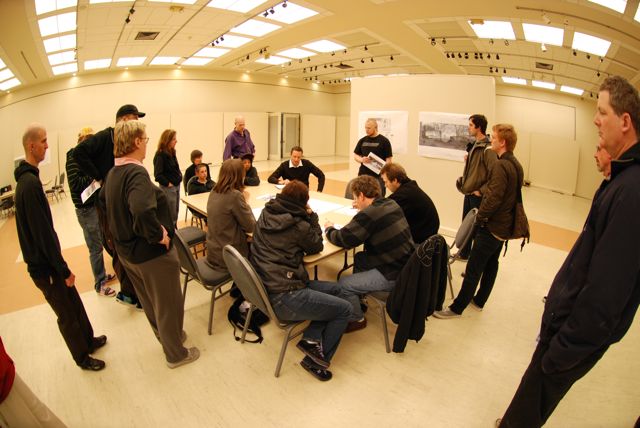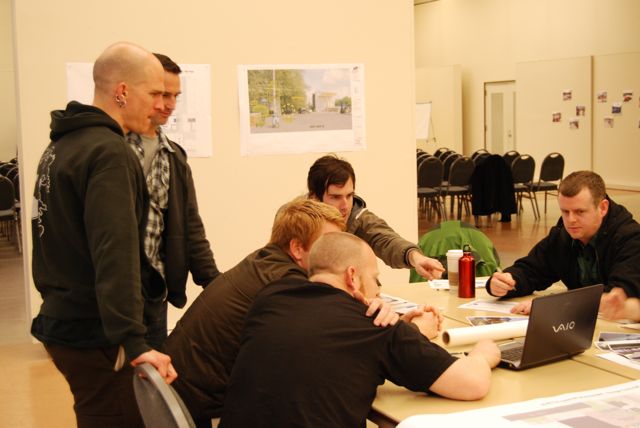SeaSk8 design meeting 1: re-cap
 Last night’s meeting was interesting. For starters, it was not very well publicized outside of posts on internet sites like this one, and as a result not that many people showed up. I counted 28 people during the meeting’s high point.
Last night’s meeting was interesting. For starters, it was not very well publicized outside of posts on internet sites like this one, and as a result not that many people showed up. I counted 28 people during the meeting’s high point.
The proceedings began with an introduction by Robert Nellams, Executive Director of Seattle Center. Then there was the usual agenda rundown which included an explanation of the process that they will be following to get to a point where they have a solid design and can start construction.
Kyle from Newline and Mark Van Der Zalm opened with a slick presentation that served as an introduction to the work they’ve done together in the past. A slide show of images from past projects like Winnipeg and Vancouver’s downtown plaza served as a pretty compelling gallery of potential ideas. Kyle also spoke about the genesis of forward-thinking skateable terrain design starting with the stuff that’s found in the wild, and then adapting it for next-level use in a public environment with less limitations.
Immediately following the presentation, there was a question from the audience about available budget, and how that number could help define the scope of the brainstorming discussion. Seattle Center’s Jill Crary responded that the budget was not itemized in a way that singled out the funds for the skatepark because it addressed the entire project including the demolition of the building and re-configuring of the underground utilities.
To me this question was mishandled and exemplifies they type of interaction that breeds distrust of public officials. Vague answers about budget on a civic project of this magnitude suggest a lack of transparency that skateboarders have become all too familiar with when dealing with the City of Seattle. There is a budget for the skatepark. It’s $900K, and the money came from the Gates Foundation when they bought the land that the old SeaSk8 used to sit on. Crary eventually coughed up this number, along with the $2.9M figure for the entire project, but it took Kyle from Newline to avoid a total meeting meltdown (people were starting to shout) by stating that “now is the time to dream. There is plenty of money for a skatepark this size.” At this point Crary quickly shuffled everyone off into groups, clearly trying to shut down any momentum toward an open public forum.
 There were two tables, and two very different discussions happening at them. At one table, Kyle had a laptop open and the skaters seemed to be brainstorming some interesting feature and design ideas. Exotic materials, dimensions, layout, and integration of transition in an interesting way, were all discussed. At the other table, it seemed like the group got bogged down in a bowl vs. street argument, primarily driven by a few people who were dead-set on having some kind of bowl in the site. From a productivity standpoint, the other table got a lot more done in my opinion.
There were two tables, and two very different discussions happening at them. At one table, Kyle had a laptop open and the skaters seemed to be brainstorming some interesting feature and design ideas. Exotic materials, dimensions, layout, and integration of transition in an interesting way, were all discussed. At the other table, it seemed like the group got bogged down in a bowl vs. street argument, primarily driven by a few people who were dead-set on having some kind of bowl in the site. From a productivity standpoint, the other table got a lot more done in my opinion.
That was pretty much it. Kyle and Mark agreed to go back and come up with some preliminary concepts to present at the next meeting.
One interesting note: Newline has hosted a forum so that people can discuss the design and provide feedback directly to them: http://www.vdz.ca/forums/forum.asp?FORUM_ID=65
I think the VDZ/Newline team are going to do a great job. The risk lies in how the Seattle Center staff (the City of Seattle) manage this process, and by manage what I really mean is whether or not they put the needs of the skaters before the whims of the businesses that feed into their profit center. They’ve already started paying considerable lip service to the needs of corporate entities like One Reel and The Bite of Seattle, who only use the center for a few days every year, but have their eyes on this skatepark site for uses other than skateboarding.
More on this in my next post…stay tuned.
MLJ
I don’t think that the “other” conversation centered around street vs. tranny at all. It was about being all inclusive of skating for a park that could very well be the center point for all skaters in Seattle. Topics included an emphasis on flow through a street area that could accommodate multiple users at a time, including a bowl/pool next to the giant 1000 degree exhaust vent, and a really constructive discussion about some sort of covering to shield skating from the rain.
There is plenty of room for a bowl/street set up like there is at Duvall where the predominant area is a street area. I think it has a great chance to be a great all around park where everyone that skates will be happy to go.
Matt:
THanks for the recap and photos. Very helpful for those who couldn’t attend-I’m sure. THanks for your confidence in us. Work continues – – – – see you in May
Tony: Thanks for the clarification. I certainly did not catch the entire discussion as I was trying to bounce back and forth to get “everything”.
I agree Duvall works but is far from optimal. They don’t have a skatepark system, they have a single skatepark, so they need to try and build as much as possible in the footprint they have. I agree it works, but But ideally that park would have more run-up and more space in general, but I’m sure the skaters there are happy because what they have is better than nothing. We are actually in a much better position than that, and skatepark advocates have fought pretty hard to make sure the resources are available to make this park the best 9K square feet of skateboarding terrain in Seattle.
Also, Duvall will not see the numbers that this park will. This park needs to serve a LOT of people at once because of it’s prominent location. We all know that a bowl is a single-user feature, so using the scarce space available for a single use feature, that has to be built above grade because we can’t dig, is the wrong approach in my opinion.
I also would like to point out that this park is going to be seen by people from all over Seattle, Washington, and even the world. It needs to be something that people can look at and say “I want that in my neighborhood”. When you or I go to a skatepark and see 2 guys skating the bowl, and 50 kids skating the street section of the park, we can reconcile that equation because we know things as skaters that make that trade-off valuable to us. But the uninitiated see it as a simple waste of space for something so underutilized. I’m afraid people are going to walk away with the impression that they don’t need a bowl in their neighborhood skatepark because let’s face it, there will hardly ever be more than one person skating that proportionately large part of the park. Maybe this fear is unjustified…it’s hard to predict what people are thinking.
What I’m really hoping is that VDZ/Newline can come up with something that transcends “bowl” and provides transition riders with something super fun, without compromising the street focus of the park. It sounds like you guys were talking about that and I missed it. That’s awesome. What I did see though, was a drawing with a third of the park blocked out and “bowl” written on it, which gave me the wrong impression.
One of the goals for this park was for it to be on par with the most advanced and creative skateparks in the world. Equitable with the Space Needle in terms of notoriety and recognition as something unique to Seattle. I’m sorry, but I think dropping a bowl into this park is a great way to make it just like a lot of other skateparks out there.
I think the designers involved are capable of creating a next-generation design that like you said, can support all types of skating, but without breaking up the flow of the whole park with a big over-ground bowl structure. Just my $.02 and I respect the bowl guys for fighting for what they believe in.